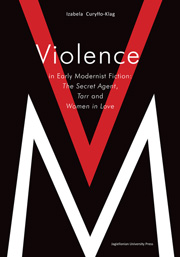Book contents
- Frontmatter
- Contents
- Acknowledgements
- Introduction
- CHAPTER I Modernist Consciousness of Crisis and the Emergent Violence Mythos
- CHAPTER II Ticking Towards Disaster—Violence as “The Enemy Within” in Conrad's The Secret Agent
- CHAPTER III “All Personality Was Catching”—Mimetic Rivalry and the Contagion of Violence in Tarr
- CHAPTER IV Humanity in a Cul-de-sac: Women in Love as an Epic of Sacrificial Crisis
- Conclusion
- Bibliography
- Frontmatter
- Contents
- Acknowledgements
- Introduction
- CHAPTER I Modernist Consciousness of Crisis and the Emergent Violence Mythos
- CHAPTER II Ticking Towards Disaster—Violence as “The Enemy Within” in Conrad's The Secret Agent
- CHAPTER III “All Personality Was Catching”—Mimetic Rivalry and the Contagion of Violence in Tarr
- CHAPTER IV Humanity in a Cul-de-sac: Women in Love as an Epic of Sacrificial Crisis
- Conclusion
- Bibliography
Summary
If there existed a ranking of the most unpleasant fictions that British—or even European—modernism ever produced, the three novels discussed in this study would most likely occupy some of the top positions. Unsparing in laying bare the darkest of human impulses, The Secret Agent, Tarr and Women in Love can make the reader flinch with understandable discomfort: one almost wishes, like Lawrence when reading Forster, that “a bomb would fall and end everything.” This, after all, is a most natural reaction to a world plunged into a sacrificial crisis, and a wish well known to the violent protagonists who must confront the murky realities dreamt up for them by the merciless authors. Yet, as Girard suggests, one should strive to overcome the mimetic impulse and look man's inhumanity in its ugly face, forsake the temptation of nihilism and try to comprehend the mechanisms behind the worst of all social plagues, which is violence. What Conrad, Lewis and Lawrence offer is an attempt at unveiling, an exposure of what we would prefer to close our eyes to—and, curiously, the Greek word for “unveiling” is “apocalypse.”
Not easy to read, the three novels were not easy to write in the first place. As with other creative works, The Secret Agent cost Conrad a depression.
- Type
- Chapter
- Information
- Violence in Early Modernist FictionThe Secret Agent, Tarr and Women in Love, pp. 112 - 116Publisher: Jagiellonian University PressPrint publication year: 2011



